Almond milk has surged in popularity as a nutritious and delicious alternative to dairy milk. Making almond milk at home not only allows you to control the ingredients but also saves money and reduces waste. This guide will walk you through the simple process of making almond milk at home, providing you with all the information you need to enjoy this creamy beverage.
| Ingredients | Tools Required |
|---|---|
| 1 cup raw almonds | Blender |
| 4 cups filtered water | Nut milk bag or cheesecloth |
| Sweetener (optional) | Glass jar or bottle for storage |
| Vanilla extract (optional) | Measuring cups |
| Pinch of salt (optional) | Strainer |
Ingredients
The primary ingredient for making almond milk is raw almonds. You will need one cup of these nuts, which are high in protein, healthy fats, and vitamins. Additionally, you will need four cups of filtered water to blend with the almonds. You can customize your almond milk with sweeteners like honey or maple syrup, a splash of vanilla extract for flavor, and a pinch of salt to enhance the taste. These optional ingredients can be adjusted according to your preference.

Tools Required
To make almond milk, you’ll need a few essential tools. A high-speed blender is crucial to ensure that the almonds are finely ground and blended with the water. A nut milk bag or cheesecloth is necessary for straining the milk, separating the almond pulp from the liquid. After straining, a glass jar or bottle is ideal for storing your freshly made almond milk. Measuring cups will help you accurately portion your ingredients, and a strainer can be handy if you don’t have a nut milk bag.

Step 1: Soak the Almonds
Start by soaking one cup of raw almonds in water for at least 8 hours or overnight. Soaking softens the almonds, making them easier to blend and helping to release their nutrients. This step is essential for achieving a creamy texture in your almond milk.

Step 2: Drain and Rinse
After soaking, drain the almonds and rinse them under cool running water. This helps remove any enzyme inhibitors and makes the almonds easier to digest. Rinsing also ensures that you are starting with clean almonds for the best flavor.

Step 3: Blend the Almonds with Water
In your blender, combine the soaked and rinsed almonds with four cups of filtered water. Blend on high for about 1-2 minutes until the almonds are finely ground and the mixture looks milky. The longer you blend, the creamier your almond milk will be.

Step 4: Strain the Mixture
After blending, it’s time to strain the mixture. Pour the blended almond mixture into a nut milk bag or cheesecloth placed over a bowl or jug. Gather the cloth and squeeze to extract as much liquid as possible. The remaining almond pulp can be saved for other recipes, like smoothies or baking.

Step 5: Sweeten and Flavor (Optional)
If you like your almond milk sweetened, now is the time to add your chosen sweetener. You can also add a splash of vanilla extract and a pinch of salt for added flavor. Blend again for a few seconds to incorporate these ingredients into the milk.

Step 6: Store Your Almond Milk
Transfer the strained almond milk into a glass jar or bottle. Seal it tightly and store it in the refrigerator. Homemade almond milk typically lasts for about 3-5 days. Always shake well before using, as it may separate over time.

Step 7: Enjoy Your Almond Milk
Your homemade almond milk is now ready to be enjoyed! Use it in smoothies, coffee, cereal, or just drink it on its own. The possibilities are endless with this versatile dairy alternative!

FAQ
Can I use roasted almonds instead of raw almonds?
Yes, you can use roasted almonds, but they will change the flavor of the almond milk. Raw almonds provide a milder taste and are generally preferred for homemade almond milk.
How can I use the leftover almond pulp?
The leftover almond pulp can be used in various recipes. You can add it to smoothies, oatmeal, or baked goods like muffins and cookies for added fiber and nutrition.
Can I make almond milk without soaking the almonds?
While soaking is recommended for a creamier texture and better digestibility, you can make almond milk without soaking. Just blend the almonds longer to achieve a smoother consistency, but the milk may be slightly grainier.
How do I make almond milk unsweetened?
To make unsweetened almond milk, simply omit any sweeteners from the recipe. You can still add a pinch of salt for flavor and enjoy the natural taste of almonds.
Is homemade almond milk healthier than store-bought?
Homemade almond milk is often healthier than store-bought options, as you can control the ingredients and avoid additives or preservatives. Plus, it usually contains fewer calories and sugar compared to many commercial almond milks.
For more information on almond nutrition and recipes, you can visit the [USDA FoodData Central](https://fdc.nal.usda.gov/) or the [California Almonds](https://www.almonds.com/) websites.
